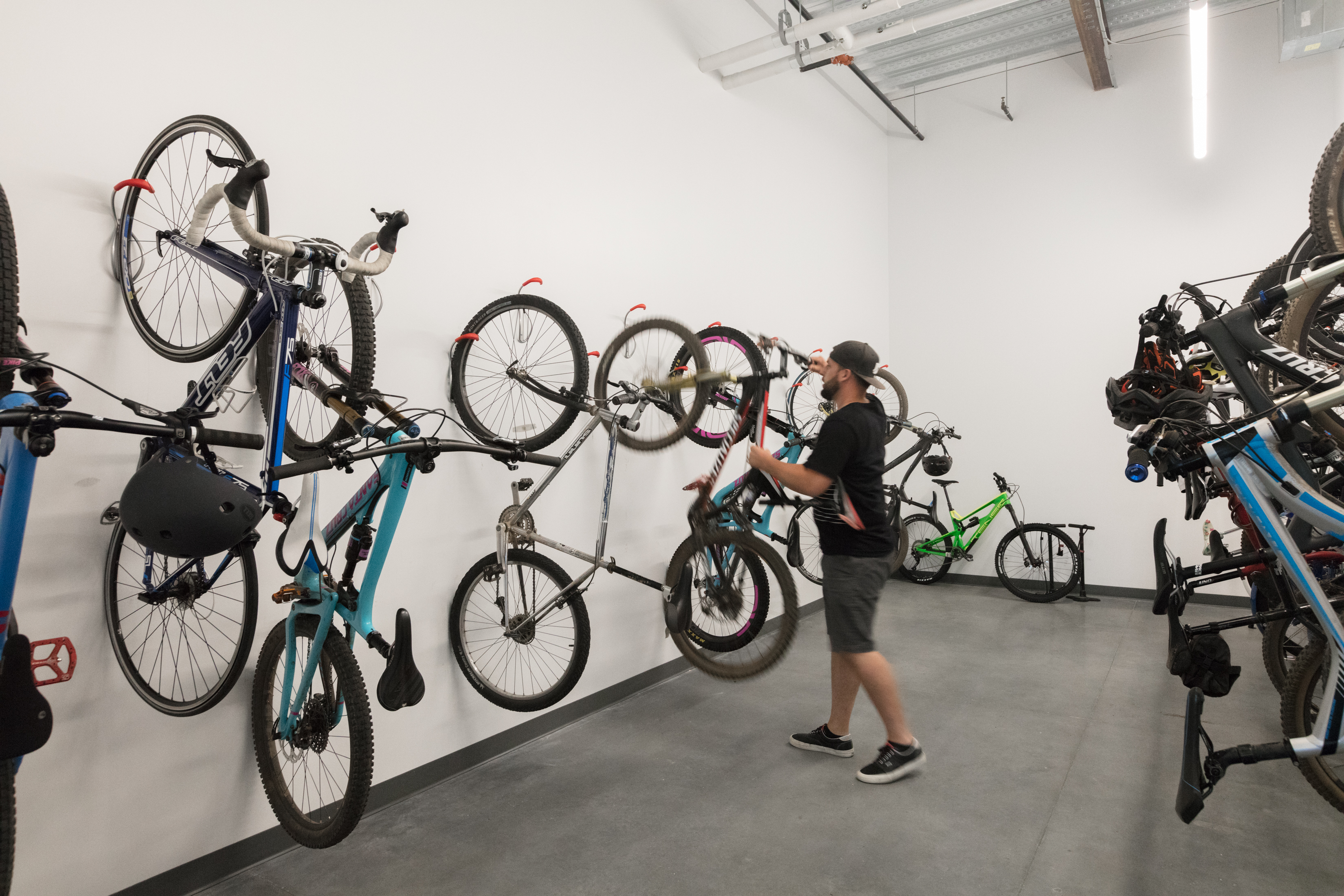10 ways smart offices are saving energy and lowering their carbon footprint


Skullcandy offers bike storage to employees at its Park City, Utah headquarters.
As buildings become smarter and more connected, it's easier than ever for companies to reduce their carbon footprint.
Living greener is important to everyone, whether at home or work. There are specific ways that smart offices can reduce their carbon footprint and make less of an impact on the environment.
Some building owners opt for LEED certification, which stands for Leadership in Energy and Environmental Design. The certification system was devised by the US Green Building Council (USGBC) and there are rating levels ranging from Silver to Platinum, depending on a building's energy efficiency.
"LEED-certified buildings have 34 percent lower CO2 emissions, consume 25 percent less energy and 11 percent less water, and have diverted more than 80 million tons of waste from landfills," said Alan Ni, director of vertical marketing for Aruba, a Hewlett-Packard Enterprise company.
"LEED is the benchmark standard for energy-efficient buildings, so it's a good reference for the percentage saved over your average inefficient building," Ni added.
Aruba took deliberate steps to improve energy efficiency when it designed a new headquarters in Santa Clara, CA.
"When the building opened in January 2017, some of the key energy-efficiency elements included smart lighting, efficient space management, asset tracking, and a large number of sensors all connected via Aruba's network infrastructure. Going forward, Aruba plans to integrate the network with the access control and other building management systems (BMS), such as HVAC. This will allow the company to closely align energy utilization with building occupancy, outside temperature, degree of sunlight, time of day, and other factors," Ni said.
Cisco offers a range of cost-saving options for companies wanting to save on energy usage. Cisco's digital building solution focuses on making buildings smarter through optimized lighting, building automation, and IoT technology. Standalone building systems are converged into one IP platform through this foundation, said Anil Menon, global president of smart cities for Cisco.
If you want to make your company more energy efficient, here are ten of the best ways to save energy and save the environment:
1. Get a carbon footprint measurement
First, find out how big a carbon footprint your office is leaving behind. The University of California, Berkeley, offers a quick calculator for businesses that gives an estimate of how many tons of CO2 per year your office creates. It's not all-inclusive, but a good starting point, and it's a way to open the conversation among your co-workers.
2. Use IoT devices and sensors to reduce energy usage
Organizations are relying on connected IoT devices and sensors throughout their facilities to identify and enact steps that allow them to heighten their efficiencies and reduce their carbon footprint -- all while increasing occupant comfort, Ni said.
"Use IoT and other sensing technologies to control lighting, the environment and other energy-consuming systems, so that when space is unoccupied, energy is not expended," said Ni. "For example, tie energy systems to your access control system, so when the last person 'badges out,' the building is set to empty state."
3. Do an energy efficiency retrofit
"An energy efficiency retrofit of an office building has many different specific actions. In most buildings, heating, venting and air conditioning (HVAC) has the biggest carbon footprint and is thus the first place to start. Methods to address this include installing a new HVAC unit which is more efficient and uses less energy; adding insulation to the building to reduce the leaking of energy to the outside; adding sensors to better detect the occupancy and temperature of a room; and the integration of the HVAC control with other aspects of the building (for example, lighting, outside shades, and so on) to best optimize the total energy use of the building," said Thomas Baker, principal with Boston Consulting Group (BCG).
4. Incorporate renewable energy
Another way that companies can be more energy efficient is to utilize renewable energy such as solar panels and integrate them into overall power management. This can be done by using smarter software and building management systems to tie the use of renewable energy to building power demand, availability and price of external energy sources, and other factors to decrease overall consumption and up the percentage of renewable energy, Ni said.
AI-powered energy storage is a smart way to reduce energy costs and lower a carbon footprint at the same time, said Gabe Schwartz, marketing director at Stem, which has an AI-driven software platform that gives companies greater grid flexibility in energy markets with a high demand.
"With energy storage the carbon footprint story is all at the macro levels. It's not like solar when you put it in a building and it just lowers the carbon footprint in that specific building. What it's actually doing, is it's actually lowering the carbon footprint of the whole electric grid," Schwartz said.
5. Manage office space
"Manage space more efficiently through the use of shared spaces and hot desking, so that the total square footage is used more efficiently and less space is needed per person. This can be done with space management software and sensors, such as smart furniture, combined with system integration, security and other systems," Ni said.
6. Maximize heating and cooling
One way to make the most of heating and cooling, Ni said, is to "recycle heat within facilities and maximize the efficiency of heating and cooling. For example, recycle water used to cool computer servers to provide hot water or, use windows to absorb heat from the sun and recirculate it. Another example: use cheap renewable electricity to make ice off hours and then chill air by blowing it over the ice, for air conditioning."
7. Recycle everything
Don't stop with recycling paper and plastic goods. Make sure that electronics are recycled as well. And instead of having one general bin or disposal area, try using clearly marked recycling bins in your office and consider adding a collection of bins for a certain number of employees in your office. In other words, if your employees are seated side by side or in groups of four, five or six, consider placing three general recycling bins at each of these worker stations. This helps to encourage positive recycling, making a big difference in terms of your company's overall carbon footprint, said Nate Masterson, marketing manager for Maple Holistics.
8. Reduce travel footprint
Employees can carpool with co-workers to reduce the amount of solo travel it takes to get to the office. Providing employees with electric vehicle charging stations is another way to encourage a smaller carbon footprint. Offering bike storage for employees who opt to cycle to work, and providing a locker room for showers and clothing changes is another way to help out cycling employees. Skullcandy offers bike storage for employees at its new headquarters in Park City, Utah, as previously reported in TechRepublic.
Another way to reduce a travel footprint is to limit employee travel. With teleconferencing, it's easy to see co-workers and clients face-to-face without ever stepping on an airplane. By traveling less, it reduces costs and shrinks a company's carbon footprint.
Implementing flexible versus fixed offices for employees is another way of limiting travel, said BCG's Baker.
9. Educate employees
Everyone in the company needs to know about green initiatives in order for them to be effective. One way to get everyone involved is to set up goals and rewards for the departments that reduce their carbon footprint the most.
"The first step to ensuring that your office remains green or gets on track with regards to ethical eco-friendly practices is to educate your employees about their role in the issue," said Masterson. "No office functions alone and the whole point of having a successful business is based on your ability to function as a team. Once employees understand how much of an impact even the simplest of tasks may have in terms of protecting the environment (things like switching off computers at the end of the day or following simple recycling practices), they'll be more likely to co-operate."
10. Keep track of energy usage
There are several companies that work to provide businesses with information about energy usage. One such company, Verdigris, has a combination hardware/software solution that identifies and creates an 'energy fingerprint' for every device in the building, and helps property owners/managers identify waste and reduce energy. Another company, GridLion, is a startup in the energy efficiency space and it combines hardware, software and strategy to support commercial buildings improve energy performance.
Zen Ecosystems offers an energy management system through its Zen HQ cloud platform to help companies control thermostats throughout their offices and manage energy costs, said CEO James McPhail.
What it all means
There are definite cost savings that can result from being more energy efficient.
"The majority of energy efficiency and renewable energy procurement programs at offices end up reducing costs -- in fact it's the economic business case that is most often driving the adoption of many of these solutions," Baker said. "We typically see energy efficiency solutions reduce an office's energy use from between 10-30 percent. Especially in regions where a company is paying a high rate for electricity or other energy, this can have a short payback of a few years and an internal rate of return (IRR) of +15 percent. The same can be true for renewable energy procurement. Especially today where we have seen the cost for renewables drastically reduce in the last couple of years and become cost-competitive with traditional sources of energy."
And the benefits of reducing a company's carbon footprint go beyond financial savings.
"Beyond cost savings, upgrades to HVAC often provides a much higher level of comfort (and thus productivity) for the occupants -- advanced sensors can detect hot or cold spots in a room and provide much more granular control. Finally, reducing a building's carbon footprint can be leveraged for branding and marketing with customers and employees who often expect their workplace to be green," said Baker.
Cisco uses its own smart building technology to build smarter offices for its own employees.
Menon said Cisco saves millions of dollars each year in operating costs by utilizing space. "We optimize the savings for all of us and it allows us to give back to the employees a work space they enjoy working in. We have places where you can get together, we have open areas, we have lobbies, in some places we have areas where you can have small meetings together like around a billiards table, things of that kind. Employees connect together, they talk to each other, they have a pleasant experience, they collaborate better together, they create better teamwork. So, if we think about this in a holistic manner, it not only about financial efficiency saving, etc, etc, asset utilization is a big improvement but in improving productivity of employees and giving them a better experience is really becomes the most important thing for us."
Also See
Salesforce sets milestone for green building with innovative water recycling system
It will feature the largest on-site blackwater recycling system in a commercial high-rise building in the US.
Will 2018 see the death of printers and email in the workplace?
As we move towards a paperless -- and email-free workplace, how will the office of the future look in five years time?
Netatmo Smart Radiator Valve, First Take: Room-level remote control
Want to keep your home or office warm more cheaply this winter? Netatmo's remote control thermostatic valves let you take control of every room to reduce your heating bill.
17 ways the Internet of Things is changing the world
At IoT World 2017, it was clear that IoT is having a profound impact on transportation, sustainability, manufacturing, city services and more. Here are 17 video interviews with tech leaders.